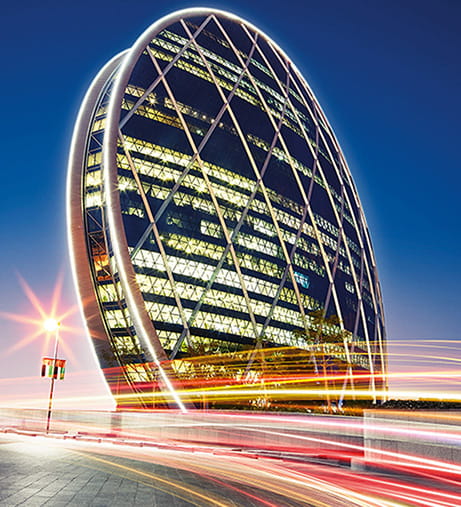#Featured
March 25, 2023
What Is a Net Zero Strategy?
Climate change and the environmental crisis have become a focus area of many countries worldwide, as they present serious issues threatening Earth's longevity and quality of life. Accordingly, many new measures, such as net zero strategies, are implemented by governments and companies to make a significant environmental change.
Continue reading to discover what a net zero strategy is, its role in reducing carbon emissions and footprint, and how Aldar's net zero strategy is implemented.
Net Zero Strategy: Definition and Types
Before addressing the definition, it is essential to understand greenhouse gas emissions. These gases primarily include Carbon Dioxide (CO2), Methane (CH4) and Nitrous Oxide (N2O), and they are produced as a result of burning fossil fuel. Generally speaking, these gases have an extremely harmful effect on the environment as they trap heat, causing climate change and damaging the environment. Additionally, they add to the severity of air pollution, causing respiratory disease. To combat this environmental crisis, net zero strategies are applied.
-
What is a Net Zero Strategy?
There are two types of net zero strategies. The first one is the Absolute Net Zero Strategy, which aims to reduce greenhouse gas (GHG) emissions to zero, hence the name. The second type is the Carbon Neutrality Strategy; it offsets these emissions by removing an equivalent amount of carbon from the atmosphere, resulting in a balance between the amount of emissions produced and the amount removed. Both types eliminate greenhouse gas emissions' effect, bringing us to our next point.
-
Who Implements Net Zero Strategies?
Reducing carbon emissions requires a vast collective effort. As a result, each of the following applies net zero strategies:
1. Governments:
Many governments worldwide implement net zero strategies stemming from the significance of climate change as a global issue. Governments also provide funding for research and facilitate the transition to net zero operations.
2. Sustainable Companies:
Businesses, organisations, and companies execute net zero strategies as part of their corporate social responsibility and sustainability goals. One of these sustainable companies is Aldar. But what are the key points to its net zero strategy? What are its goals and targets? What are the focus activities?
Aldar’s Net Zero Strategy: Targets
Like all net zero strategies, the one carried out by Aldar has the ultimate goal of reducing carbon emissions. Additionally and exclusive to Aldar, the strategy aims to turn the real estate developer into a net zero business by 2025. Therefore, this strategy represents significant leadership in climate action and decarbonisation across the real estate sector.
The strategy comprises the following targets:
1. Net Zero Scope 1 & 2 Emissions by 2030
Scope 1 emissions are direct greenhouse (GHG) emissions produced from sources controlled or owned by an organisation or company. On the other hand, scope 2 emissions are indirect (GHG) emissions produced by generating electricity, steam, heat, or cooling. Even though the second scope emissions are generated in facilities physically apart from the organisation, Aldar in this instance, they are still accounted for Aldar’s greenhouse gas emissions due to the company’s energy use.
2. Net Zero Scope 1, 2 and 3 Emissions by 2050
Simply put, scope 3 emissions are known to be indirect emissions, and they are the result of a company’s activities, which are not under its direct control. These emissions are related to the company’s value chain, yet they are not part of 1 and 2 emissions' scope. Before exploring this target further, it is important to note that a value chain is a series of activities creating and adding value to properties. These activities begin from the time of acquiring land and continue until the property is sold and leased, and they aim to make properties more attractive for potential buyers and tenants.
With that said, Aldar’s net zero strategy aims to reach a net zero for scope 1, 2 and 3 emissions. This target follows the carbon footprint reduction to be achieved by 2030, and it heavily depends on sustained structural change to drive the scope 3 decarbonisation process. With this long-term goal, Aldar will become a net zero business, providing developments with minimal or no greenhouse gas emissions throughout the process and each development's lifecycle.
Aldar’s Net Zero Strategy: Focus Activities
Each net zero strategy has different focus activities, depending on the organisation's vision, goals, and field. Aldar’s net zero strategy has the following focus activities driving the environmental impact:
1. Low-Carbon Design:
Achieved by using low-carbon concrete and steel in all projects and integrating other low-carbon materials as the supply chain matures.
2. Green Construction:
Mainly done by reducing waste through improved material management, introducing low-carbon construction site practices, and electrifying construction sites where feasible.
3. Clean Energy:
This is done by introducing on-site clean energy generation to tackle residual emissions.
Aldar's net zero strategy comprises impressive focus activities aiming to achieve significant environmental impact throughout the real estate sector. Check out Aldar's net zero strategy now for more details.

